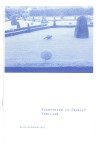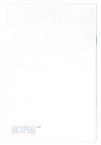Artspeak
-
Chto delat / What is to be done?
Chto delat / What is to be done? is a collective whose name derives from a novel by the Russian author Nikolai Chernyshevsky, as well as from Lenin’s political text Chto delat from 1902. The collective acts at the intersection of political theory, art, and political activism, and includes artists, critics, philosophers, and writers. Since 2003, Chto delat has been publishing an English-Russian newspaper examining the re-politicization of Russian intellectual culture in its broader international context.
-
Isabelle Cornaro was born in 1974. She lives and works in Paris. She studied at the Fine Arts School of Paris and at the Royal College of Arts in London. Her work has been exhibited at the Museum of Modern Art of the City of Paris; Kunstlerhaus, Stuttgart; Drawing Center, New York. In 2008 she had solo shows at the art center of Noisiel La Ferme du Buisson, and at the Düsseldorf Kunstverein. Her work is represented by Galerie Balice Hertling in Paris.
-
Keren Cytter is a Berlin based artist whose film work has been shown widely, including at the Irish Museum of Modern Art, Dublin; Stedelijk Museum, Amsterdam; Museum Moderner Kunst Stiftung Ludwig, Vienna; Galleria d’Arte Moderna e Contemporanea, Bergamo; Kunsthalle Zurich; Frankfurter Kunstverein; and KW Institute for Contemporary Art, Berlin. Cytter is also a writer and has published three novels.
-
Tarje Eikanger Gullaksen is a Norwegian artist currently living and working in Berlin. He studied Fine Art and Art Theory at the Royal Danish Academy of Fine Arts, and his artistic practice includes text, photo, film, installation, and sculpture. His work investigates objects and signs in relation to concepts such as language, transgression, representation, transformation, and loss. He has recently shown works at Museum of Modern Art, Aalborg; Galerie Mehdi Chouakri, Berlin; and Bastarden, Oslo. In 2010 he will have a solo presentation of his work at UKS, Oslo.
-
Susan Hiller is an American born artist based in the UK. Her practice encompasses installation, video, photography, performance, and writing. She describes her work as a kind of ‘archaeological investigation, uncovering something to make a different kind of sense of it’. The Tate Gallery (London), will initiate a major mid-career retrospective of her work next year. A new book entitled The Provisional Texture of Reality provides insights into her influential practice.
-
Renske Janssen is a Rotterdam based curator. She has been curator at the Witte de With since 2006. She has a Masters title in Contemporary Art Theory and Dutch Art Policy from the University of Utrecht. She collaborated on For Real (2000), Display (2001) and Life in a Glass House (2002) at the Stedelijk Museum in Amsterdam. At the Stedelijk Museum Bureau Amsterdam she organized Bantar Gebang (De Rijke/De Rooij) and Mindset (Saskia Olde Wolbers). For the Witte de With she has curated solo exhibitions of the work of Mathias Poledna (2006), Tris Vonna-Michell (2007) and Ian Wallace (2008). For the Kunstverein fuer die Rheinlande und Westfalen she recently curated Aesthetics as a way of Survival with Germaine Kruip (2009). She is currently developing a three day cycle on the idea of performance for Witte de With’s Morality program under the working title Let Us Compare Mythologies.
-
Sharon Kahanoff is a filmmaker, artist, writer and educator. Her works have been exhibited in both cinemas and galleries locally and in the U.S., and she has published in exhibition catalogues, art magazines and other art publications. She is a sessional instructor at Simon Fraser and Emily Carr Universities, a volunteer and board member of Artspeak gallery, and she sits on the program advisory committee at Cineworks. Her interests include the performance and theatricality of social relations in contemporary re-enactment art, and the philosophies and ethics of time expressed through the moving image.
-
Una Knox is a Vancouver and London, UK based artist whose work has been shown at Postmasters Gallery, New York; Or Gallery, Vancouver; Presentation House Gallery, North Vancouver; Cornerhouse, Manchester. She is part of New Contemporaries 09, London and a recipient of The Red Mansion Art Prize 09.
-
Eliza Newman-Saul is an artist based in Amsterdam. She completed de ateliers in Amsterdam in 2009. She is currently in residence at the Irish Museum of Modern Art (Dublin). Her work has been commissioned by SKOR’s de Inkijk (Amsterdam) and Corcoran’s Project for the Arts (Washington, DC). Her work was selected for Explum ’09 (Murcia, Spain), the 2007 Scope Art Fair (New York), Smack Mellon (Brooklyn), and PS1/MOMA Contemporary Art Center in conjunction with N+1 (Queens, NY). Her lectures have appeared in Performance Research Journal (Routledge Press) and N+1’s first pamphlet publication (N+1 Research Branch).
-
Judy Radul’s work has been exhibited nationally and internationally, including solo exhibitions at Belkin Satellite, Vancouver; Contemporary Art Gallery, Vancouver; and Power Plant, Toronto. She has performed widely, including at the Western Front, Vancouver and Institute of Contemporary Art, London UK.
Exhibitions
Underground Man
ISABELLE CORNARO, KEREN CYTTER, CHTO DELAT / WHAT IS TO BE DONE?, TARJE EIKANGER GULLAKSEN, SUSAN HILLER, UNA KNOX, ELIZA NEWMAN-SAUL
November 18–January 16, 2010
Underground Man is a project that consists of performance, film screenings, conversation, and a publication that takes method acting as a starting point. This way of acting or dealing with form, language, and representation is one of the most discussed methods in theatre and film, but within contemporary art it is applied in a more disguised (or natural) manner. This project, a case study of sorts, questions if method acting is a way to curb the self within a highly constructed and staged society. How do we act and how do we look at what is depicted?
The title refers to Dostoevsky’s Notes from Underground in which the author portrays humans as irrational, uncontrollable, and uncooperative. The novel was considered a forerunner of existentialist thought and conjures up notions of going undercover in order to find information, to move in a space between the collective and the individual, off stage and on stage, between visibility and invisibility, and to be able to stage a context for oneself in order to act upon freely.
In trying to find a new language to discuss the way we live and work, method acting is a metaphor not only for actors. With this in mind, it allows the self to respond differently and flexibly in new situations. But it requires a fine balance between memory and the present—bridging expressions between nature and artificiality, subject, and object—to create radical breaks with the past for the sake of continuity. What becomes visible and what stays invisible? How do we choose?
As method acting requires the use of the self for the sake of external representation, the artists in this project respond to thoughts on form and method, surface and interior, and incorporate performance and film.
Talks & Events
-
RENSKE JANSSEN, SHARON KAHANOFF, ELIZA NEWMAN-SAUL, JUDY RADUL
November 21, 2009Public conversation between Renske Janssen, Eliza Newman-Saul, Judy Radul and Sharon Kahanoff. The subjects will range from work descriptions and anecdotes to contemplation on the power of representation and the potential of suspense.
Underground Man is a project that consists of performance, film screenings, conversation, and a publication that takes method acting as a starting point. This way of acting or dealing with form, language, and representation is one of the most discussed methods in theatre and film, but within contemporary art it is applied in a more disguised (or natural) manner. This project, a case study of sorts, questions if method acting is a way to curb the self within a highly constructed and staged society. How do we act and how do we look at what is depicted?
The title refers to Dostoyevsky’s Notes from Underground in which the author portrays humans as irrational, uncontrollable, and uncooperative. The novel was considered a forerunner of existentialist thought and conjures up notions of going undercover in order to find information, to move in a space between the collective and the individual, off stage and on stage, between visibility and invisibility, and to be able to stage a context for oneself in order to act upon freely.
In trying to find a new language to discuss the way we live and work, method acting is a metaphor not only for actors. With this in mind, it allows the self to respond differently and flexibly in new situations. But it requires a fine balance between memory and the present—bridging expressions between nature and artificiality, subject, and object—to create radical breaks with the past for the sake of continuity. What becomes visible and what stays invisible? How do we choose?
As method acting requires the use of the self for the sake of external representation, the artists in this project respond to thoughts on form and method, surface and interior, and incorporate performance and film.
-
Underground Man: Film Screening
ISABELLE CORNARO, KEREN CYTTER, CHTO DELAT / WHAT IS TO BE DONE?, TARJE EIKANGER GULLAKSEN, SUSAN HILLER, UNA KNOX, ELIZA NEWMAN-SAUL
November 19, 2009FILM SCREENING
Thursday, November 19, 2009 at 8pm (OFFSITE at Vancity Theatre, 1181 Seymour Street)
Una Knox, When What Becomes Who, 2009, 11:27
Keren Cytter, Four Seasons, 2009, 12:00
Tarje Eikanger Gullaksen, Unfinished Symphony, 2009, 19:00
Eliza Newman-Saul, Nothing Will Come of Nothing, 2009, 9:24
Chto Delat/What is to be done?, Partisan Songspiel, 2009, 29:00
Isabelle Cornaro, Premier rêve d’Oskar Fischinger, 2008, 1:41 and 1:33
Susan Hiller, The Last Silent Movie, 2007, 20:00
-
Everything is Equally Familiar
ELIZA NEWMAN-SAUL
November 18, 2009Eliza Newman-Saul’s 20-minute performance creates a unique moment of disembodiment by isolating the performer’s body and voice (performed by Natalie Schneck and Sarah Madigan). The performance installation can be viewed in the gallery until January 16, 2010. The script is available as a small publication, Everything is Equally Familiar.
Publications
-
Everything is Equally Familiar
Title: Everything is Equally Familiar
Category: Artist Book
Artist: Eliza Newman-Saul
Writers: Eliza Newman-Saul
Publisher: Artspeak
Year published: 2009
Pages: 30pp
Cover: Paper
Binding: Staple Bound
Process: Offset
Features: 2 single colour images, 1 illustration
Dimensions: 18 x 12.5 0.3 cm
Weight: 31 g
Price: Free

